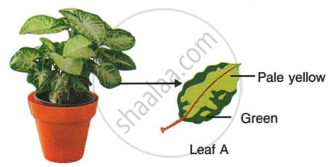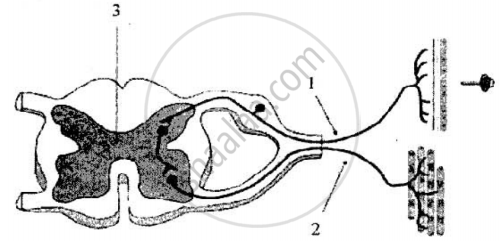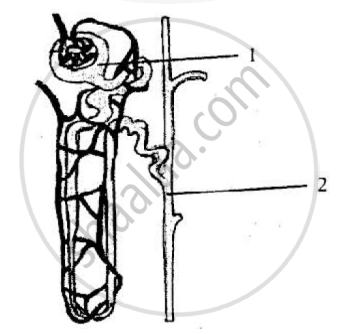(English Medium)
Academic Year: 2017-2018
Date: मार्च 2018
Advertisements
Question 1 is Compulsory
Attempt Any Four Question From Question 2 to Question 7
Name the following:
The organization which procures and supplies blood during an emergency
Chapter: [0.071] Health Organisations
Name the following:
The blood vessel which supplies blood to the liver.
Chapter: [0.031] The Circulatory System
Name the following:
The number of chromosomes present in a nerve cell of a human being.
Chapter: [0.012] Cell Cycle, Cell Division and Structure of Chromosomes [0.013000000000000001] Genetics – Some Basic Fundamentals
Name the following :
The layer of the eyeball that forms the transparent Cornea
Chapter: [0.033] Nervous System and Sense Organs
Name the following :
The wax-like layer on the epidermis of leaves which reduces transpiration.
Chapter: [0.021] Absorption by Roots: The Processes Involved
The number of Spinal nerves in a human being are :
(A) 31 pairs
(B) 10 pairs
(C) 21 pairs
(D) 30 pairs
Chapter: [0.033] Nervous System and Sense Organs
Which one of the following is non-biodegradable?
(A) DDT
(B) Vegetable peel
(C) Cardboard
(D) Bark of trees
Chapter: [0.06] Pollution
Aqueous humour is present between the :
(A) Lens and Retina
(B) Iris and Lens
(C) Cornea and Iris
(D) Cornea and Lens
Chapter: [0.033] Nervous System and Sense Organs
A strong chemical substance which is used on objects and surfaces in our surroundings to kill germs:
Cresol
Carbolic acid
Iodine
Mercurochrome
Chapter: [0.07200000000000001] Aids to Health
Which one of the following is a Greenhouse gas?
Oxygen
Methane
Sulphur dioxide
Nitrogen
Chapter: [0.06] Pollution
Complete the following paragraph by filling in the blank (1) to (5) with appropriate words:
To test a leaf for starch, the leaf is boiled in water to (1) _________. It is then boiled in Methylated spirit to (2) ________. The leaf is dipped in warm water to soften it. It is placed in a petri dish, and (3) _____ solution is added. The region of the leaf which contains starch, turns (4) ________and the region while does not contain starch, turns (5) __________.
Chapter: [0.023] Photosynthesis: Provider of Food for All [0.023] Photosynthesis: Provider of Food for All
Match the items given in Column A with the most appropriate ones in Column B and rewrite the correct matching pairs
| Column A | Column B | ||
| 1 | Cretinism | a | Hypersecretion of the adrenal cortex |
| 2 | Diabetes insipidus | b | Hyposecretion of Thyroxine |
| 3 | Exophthalmic Goitre | c | Hyposecretion of growth hormone |
| 4 | Adrenal virilism | d | Hyposecretion of Vasopressin |
| 5 | Dwarfism | e | Hyposecretion of the adrenal cortex |
| f | Hypersecretion of Growth hormone | ||
| g | Hypersecretion of thyroxine |
Chapter: [0.034] The Endocrine System
Correct the following statements by changing the underlined words:
The normal pale yellow colour of the urine is due to the presence of the pigment Melanin.
Chapter: [0.032] The Excretory System (Elimination of Body Wastes)
Correct the following statements by changing the underlined words:
The outermost layer of Meninges is Pia mater.
Chapter: [0.033] Nervous System and Sense Organs
Correct the following statements by changing the underlined words:
The cell sap of root hair is Hypotonic.
Chapter: [0.033] Nervous System and Sense Organs
Correct the following statements by changing the underlined words:
Xylem transports starch from the leaves to all parts of the plant body
Chapter: [0.021] Absorption by Roots: The Processes Involved
Advertisements
Correct the following statement by changing the underlined word:
Nitrogen bonds are present between the complementary nitrogenous bases of DNA.
Chapter: [0.012] Cell Cycle, Cell Division and Structure of Chromosomes
Blood in the renal artery or renal vein (Which one has more urea ?)
Chapter: [0.032] The Excretory System (Elimination of Body Wastes)
Perilymph or endolymph (Which one surrounds the organ of Corti ?)
Chapter: [0.033] Nervous System and Sense Organs [0.034] Sense Organs
Lenticels or stomata (Which one remains open always ?)
Chapter: [0.021] Absorption by Roots: The Processes Involved
Sclerotic layer or choroid layer.(Which one forms the Iris ?)
Chapter: [0.033] Nervous System and Sense Organs [0.034] Sense Organs
Blood in the pulmonary artery or pulmonary vein (Which one contains less oxyhaemoglobin ?)
Chapter: [0.031] The Circulatory System
Given below is a representation of a type pollution.
Study the picture and answer the questions :

1) Name the type of pollution shown in the picture
2) Name one source of this pollution
3) How does this pollution affect human health?
4) Write one measure to reduce this pollution
5) State one gaseous compound that leads to the depletion of the ozone layer and creates ‘Ozone holes’.
Chapter: [0.06] Pollution
Choose the ODD one out from the following terms given and name the CATEGORY to which the others belong:
Detergents, X-rays, sewage, oil spills
Chapter: [0.06] Pollution
Choose the ODD one out from the following terms given and name the CATEGORY to which the others belong:
Lumen, muscular tissue, connective tissue, pericardium
Chapter:
Choose the ODD one out from the following terms given and name the CATEGORY to which the others belong:
Dendrites, Medullary sheath, Axon, Spinal cord
Chapter: [0.033] Nervous System and Sense Organs
Choose the ODD one out from the following terms given and name the CATEGORY to which the others belong
Centrosome.Cell wall, Cell membrane, Large vacuoles
Chapter: [0.012] Cell Cycle, Cell Division and Structure of Chromosomes [0.013000000000000001] Genetics – Some Basic Fundamentals
Choose the ODD one out from the following terms given and name the CATEGORY to which the others belong :
Prostate gland, Cowper’s gland, seminal vesicle, seminiferous tubules
Chapter: [0.035] The Reproductive System
The diagram given below represents a stage during cell division.
Study the same and answer the questions that follow:

- Identify whether it is a plant cell or an animal cell. Give a reason in support of your answer.
- Name the stage depicted in the diagram. What is the unique feature observed in this stage?
- Name the type of cell division that occurs during:
- Replacement of old leaves by new ones
- Formation of gametes
- What is the stage that comes before the stage shown in the diagram?
- Draw a neat, labelled diagram of the stage mentioned in (iv) above keeping the chromosome number constant.
Chapter: [0.012] Cell Cycle, Cell Division and Structure of Chromosomes
Mention the exact location of Epididymis
Chapter: [0.033] Nervous System and Sense Organs
Mention the exact location of the Lacrimal gland
Chapter: [0.033] Nervous System and Sense Organs
Mention the exact location of Malleus
Chapter: [0.033] Nervous System and Sense Organs
Advertisements
Mention the exact location of Hydathodes
Chapter: [0.033] Nervous System and Sense Organs
Mention the exact location of the Pulmonary semilunar valve
Chapter: [0.031] The Circulatory System
Given below are diagrams showing the different stages in the process of fertilisation of an egg. in the human female reproductive tract.
Study the diagrams and answer the questions:
1) Arrange the letters given below each diagram in a logical sequence to show the correct order in the process of fertilisation.
2) Where does fertilisation normally take place? and What is ‘Implantation’ that follows fertilisation?
3) Mention the chromosome number of the egg and zygote in humans.
4) Explain the term ‘Gestation’. How long does Gestation last in humans?
5) Draw a neat, labelled diagram of a mature human sperm.
Chapter: [0.035] The Reproductive System
A potted plant with variegated leaves was taken in order to prove a factor necessary for photosynthesis. The potted plant was kept in the dark for 24 hours and then placed in bright sunlight for a few hours. Observe the diagrams and answer the questions:

- What aspect of photosynthesis is being tested in the above diagram?
- Represent the process of photosynthesis in the form of a balanced equation.
- Why was the plant kept in the dark before beginning the experiment?
- What will be the result of the starch test performed on Leaf ‘A’ shown in the diagram? Give an example of a plant with variegated leaves
- Draw a neat labelled diagram of a chloroplast.
Chapter: [0.023] Photosynthesis: Provider of Food for All
The diagram given below shows the internal structure of a spinal cord depicting a phenomenon. Study the diagram and answer the questions:

1) Name the phenomenon that is depicted in the diagram. Define the phenomenon.
2) Give the technical term for the point of contact between the two nerve cells.
3) Name the parts numbered 1, 2 and 3.
4) How does the arrangement of neurons in the spinal cord differ from that of the brain?
5) Mention two ways by which the spinal cord is protected in our body.
Chapter: [0.033] Nervous System and Sense Organs
Give appropriate biological or technical terms for the following:
The process of maintaining water and salt balance in the blood.
Chapter: [0.032] The Excretory System (Elimination of Body Wastes)
Give appropriate biological or technical terms for the following :
Hormones which regulate the secretion of other endocrine glands.
Chapter: [0.034] The Endocrine System
Give appropriate biological or technical terms for the following :
Movement of molecules of a substance from their higher concentration to lower concentration when they are in direct contact.
Chapter: [0.021] Absorption by Roots: The Processes Involved
Give appropriate biological or technical terms for the following :
The condition in which a pair of chromosomes carries similar alleles of a particular character.
Chapter: [0.012] Cell Cycle, Cell Division and Structure of Chromosomes [0.013000000000000001] Genetics – Some Basic Fundamentals
Give appropriate biological or technical terms for the following :
The complex consisting of a DNA strand and a core of histones
Chapter: [0.031] The Circulatory System
Give appropriate biological or technical terms for the following:
The onset of menstruation in a young girl
Chapter: [0.035] The Reproductive System
Give appropriate biological or technical terms for the following:
Squeezing out of white blood cells from the capillaries into the surrounding tissues.
Chapter: [0.031] The Circulatory System
Give appropriate biological or technical terms for the following :
The fluid which surrounds the foetus
Chapter: [0.035] The Reproductive System
Give appropriate biological or technical terms for the following
The relaxation phase of the heart.
Chapter: [0.031] The Circulatory System
Give appropriate biological or technical terms for the following :
The difference between the birth rate and the death rate
Chapter: [0.04] Population
The diagram given below is that of a structure present in a human kidney.
Study the same and answer the questions that follow:

1) Name the structure represented in the diagram
2) What is the liquid entering part ‘1’ called?
Name two substances present in this liquid that are reabsorbed in the tubule.
3) What is the fluid that comes to part ‘2’ called?
Name the main nitrogenous waste in it.
4) Mention the three main steps involved in the formation of the fluid mentioned in (iii) above
5) Name the substance which may be present in the fluid in part ‘2’ if a person suffers from Diabetes mellitus.
Chapter: [0.032] The Excretory System (Elimination of Body Wastes)
Differentiate between the following pairs on the basis of what is indicated in the brackets.
Leaf and Liver [form in which glucose is stored]
Chapter: [0.023] Photosynthesis: Provider of Food for All [0.023] Photosynthesis: Provider of Food for All
Differentiate between the following pairs on the basis of what is indicated in the brackets.
ATP and AIDS [expand the abbreviations]
Chapter: [0.034] The Endocrine System
Differentiate between the following pairs on the basis of what is indicated in the brackets.
Testosterone and Oestrogen [organ which secrets]
Chapter: [0.034] The Endocrine System
Differentiate between the following pair on the basis of what is indicated in the bracket.
Ureter and Urethra [function]
Chapter: [0.032] The Excretory System (Elimination of Body Wastes)
Differentiate between the following pairs on the basis of what is indicated in the brackets.
Hypotonic solution and Hypertonic solution [condition of a plant cell when placed in them]
Chapter: [0.021] Absorption by Roots: The Processes Involved
Given below is a diagram of a human blood smear.
Study the diagram and answer the questions that follow:

a) Name the components numbered ‘1’ to ‘4’
b) Mention two structural differences between the parts ‘1’ and ‘2’.
c) Name the soluble protein found in part ‘4’ which forms insoluble threads during clotting of blood.
d) What is the average lifespan of the component numbered ‘1’ ?
e) Component numbered ‘1’ do not have certain organelles but are very efficient in their function. Explain
Chapter: [0.031] The Circulatory System
Give biological explanations for Education is very important for population control.
Chapter: [0.04] Population
Give biological explanations for The placenta is an important structure for the development of a foetus
Chapter: [0.035] The Reproductive System
Give biological explanations for All the food chains begin with green plants.
Chapter: [0.035] The Reproductive System
Give biological explanations for Plants growing in fertilized soil are often found to wilt if the soil is not adequately watered.
Chapter: [0.023] Photosynthesis: Provider of Food for All [0.023] Photosynthesis: Provider of Food for All
Give biological explanations for We should not put sharp objects into our ears.
Chapter: [0.033] Nervous System and Sense Organs [0.034] Sense Organs
The diagram below represents a process in plants. The setup was placed in bright sunlight. Answer the following questions:

a) Name the physiological process depicted in the diagram.
Why was oil added to the water?
b) When placed in bright sunlight for four hours, what do you observe with regard to the initial and final weight of the plant? Give a suitable reason for your answer
c) What happens to the level of water when this setup is placed in:
- Humid conditions?
- Windy conditions?
d) Mention any three adaptations found in plants to overcome the process mentioned in (i).
e) Explain the term ‘Guttation’.
Chapter: [0.021] Absorption by Roots: The Processes Involved
A pea plant which is homozygous for green pods which are inflated [GGII] is crossed with a homozygous plant for yellow pods which are constricted [ggii]. Answer the following questions;
a) Give the phenotype and genotype of the F1 generation.
Which type of pollination has occurred to produce F1 generation?
b) Write the phenotypic ratio of the F2 generation
c) Write the possible combinations of the gametes that can be obtained if two F1 hybrid plants are crossed.
d) State Mendel’s law of ‘Segregation of Gametes’
5) What is the scientific name of the plant which Mendel used for his experiments on inheritance?
Chapter: [0.013000000000000001] Genetics – Some Basic Fundamentals
Other Solutions
Submit Question Paper
Help us maintain new question papers on Shaalaa.com, so we can continue to help studentsonly jpg, png and pdf files
CISCE previous year question papers ICSE Class 10 Biology with solutions 2017 - 2018
Previous year Question paper for CISCE ICSE Class 10 -2018 is solved by experts. Solved question papers gives you the chance to check yourself after your mock test.
By referring the question paper Solutions for Biology, you can scale your preparation level and work on your weak areas. It will also help the candidates in developing the time-management skills. Practice makes perfect, and there is no better way to practice than to attempt previous year question paper solutions of CISCE ICSE Class 10 .
How CISCE ICSE Class 10 Question Paper solutions Help Students ?
• Question paper solutions for Biology will helps students to prepare for exam.
• Question paper with answer will boost students confidence in exam time and also give you an idea About the important questions and topics to be prepared for the board exam.
• For finding solution of question papers no need to refer so multiple sources like textbook or guides.
